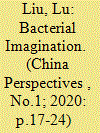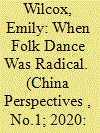|
|
|
Sort Order |
|
|
|
Items / Page
|
|
|
|
|
|
|
| Srl | Item |
| 1 |
ID:
172995


|
|
|
|
|
| Summary/Abstract |
This paper studies the critical role of the microscope in subject formation of early 1950s People’s Republic of China. The campaign against alleged germ warfare (xijun zhan 細菌戰) in 1952 politicised the action of seeing the enemy through the discourse of science. Widely used for science education and mass mobilisation for the campaign, the microscope was at once visual technology and an apparatus of power, magnifying hidden and invisible enemies that threatened the new regime. This paper argues that “seeing the enemy” was the hygienic practice of weisheng (衛生), which took on a new meaning of abjection in the early 1950s. By looking into news reports, visual materials, and science writing from this period, this paper proposes a transdisciplinary methodology for studying PRC history that brings together psychoanalysis, visual culture studies, and the history of science and technology.
|
|
|
|
|
|
|
|
|
|
|
|
|
|
|
|
| 2 |
ID:
172994


|
|
|
|
|
| Summary/Abstract |
This article argues that the advent of the technological system of CinemaScope in socialist China should be understood as a historical product of the specific material, cultural, and political conditions and configuration of the Cold War. On the one hand, it is the cultural network of the communist bloc that enabled China to obtain this new technology of media infrastructure. On the other hand, the social discourse of CinemaScope embodies the Manichaean Cold War narrative that worked to justify the political-ideological supremacy of communism by articulating a technological modernisation superior to the capitalist model. What is more, CinemaScope also bespeaks the logistics of perception that effectively turns people’s perceptual experience into a political battlefield of the Cold War.
|
|
|
|
|
|
|
|
|
|
|
|
|
|
|
|
| 3 |
ID:
172993


|
|
|
| 4 |
ID:
172996


|
|
|
|
|
| Summary/Abstract |
After the establishment of the People’s Republic of China (PRC), dubbed Soviet films became an important tool to promote the Sino-Soviet alliance among the Chinese people. This essay explores the representation of the Soviet allies through the dubbing of Soviet films in 1950s China, with a focus on not only the content of these voices, but also the techniques and aesthetics of voicing. It shows that although designed by the PRC to produce an image of the Soviets as relatable and familiar, these films also produced an image of strangers, which allowed alternative imaginations of the Soviet characters and the Sino-Soviet relationship. This paper argues for the ambiguity of the image of the “Soviet big brothers” in dubbed films in the 1950s, which disrupted the official imagination of the relationship between the Chinese and the world.
|
|
|
|
|
|
|
|
|
|
|
|
|
|
|
|
| 5 |
ID:
172997


|
|
|
|
|
| Summary/Abstract |
This article challenges three common assumptions about Chinese socialist-era dance culture: first, that Mao-era dance rarely circulated internationally and was disconnected from international dance trends; second, that the yangge movement lost momentum in the early years of the People’s Republic of China (PRC); and, third, that the political significance of socialist dance lies in content rather than form. This essay looks at the transformation of wartime yangge into PRC folk dance during the 1950s and 1960s and traces the international circulation of these new dance styles in two contexts: the World Festivals of Youth and Students in Eastern Europe, and the schools, unions, and clan associations of overseas Chinese communities in Hong Kong, Singapore, Malaysia, and San Francisco. By tracing the emergence and circulation of yangge and PRC folk dance, I propose the existence of “Cold War yangge” – a transnational phenomenon in which Chinese folk dance became a site of leftist political activism.
|
|
|
|
|
|
|
|
|
|
|
|
|
|
|
|
|
|
|
|
|